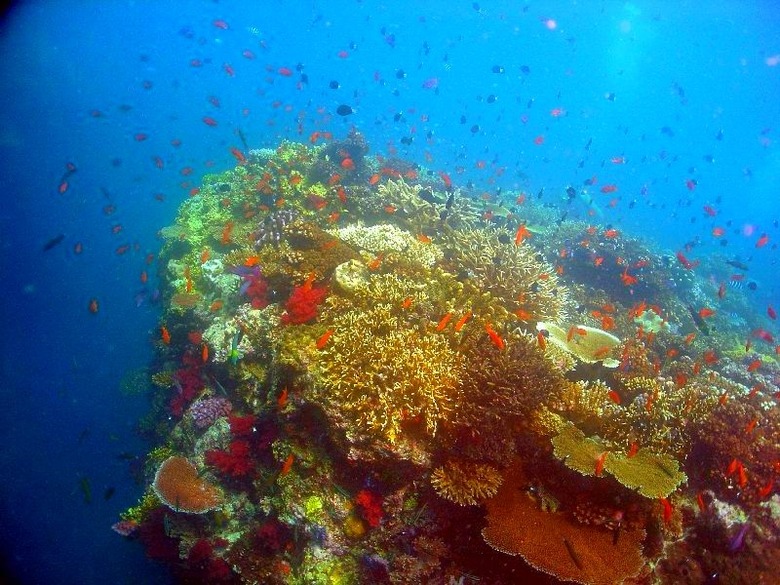Why Coral Reefs Come In Many Colors
Coral reefs are unique ecosystem structures built by invertebrate coral animals in partnership with algae called zooxanthellae. Coral types come in all kinds of shapes, sizes and colors. The colors arise from the symbiosis with the algae, and the color's appearance depends on the light in the water.
TL;DR (Too Long; Didn't Read)
Coral reefs are unique ecosystem structures built by invertebrate coral animals in partnership with a kind of algae. This algae gives corals some of their colors via chlorophyll, and other, more vivid colors result from gene expression in the coral.
What Are the Different Colors of Coral?
What Are the Different Colors of Coral?
Corals are part of the phylum Cnidaria. Cnidarians are invertebrate marine animals that are related to jellyfish and sea anemones. Coral types and colors can range from blues, purples, greens, reds and pinks, to greens and so on. Some corals are quite spectacularly vibrant in color, while other corals are more subtle. All corals have green-brown tints in the coral caused by the zooxanthellae algae, which have chlorophyll-containing cells that help provide food for the coral and the algae itself.
The many colors of coral occur due to gene expression. These genes code for proteins in different wavelengths such as green, cyan, and red. These provide corals with some of the fluorescent hues they have. Researchers believe these fluorescent pigments (FPs) work as a form of sunscreen to protect corals from sun damage and coral bleaching.
Fluorescent corals prefer shallower water with more sunlight. Where conditions are too bright, and corals need fast protection, they can also squeeze their bodies together, so the pigments are more concentrated.
How Do Colorful Corals Help Ecosystems?
How Do Colorful Corals Help Ecosystems?
Vivid-hued coral reefs host tremendous species diversity. Brightly colored fish blend in among vibrantly colored corals. The fish can better hide from predators when they match the colorful backdrop of corals.
However, in areas of coral bleaching, bright fish stand out more and are more susceptible to predation. This is one reason coral bleaching threatens the delicate balance of life in coral reefs.
What Is Coral Bleaching?
What Is Coral Bleaching?
Coral reefs are threatened by stressors caused by climate change, such as ocean acidification and warmer temperatures. Corals under stress release their symbiotic algae, exposing their pale skeletons. This phenomenon is known as coral bleaching. Coral bleaching can lead to starvation of corals, for once the symbiotic algae vanish, their chlorophyll production goes with them. The coral animals need up to 90 percent of the sugars algae produce for them.
Coral polyps can use fluorescent pigments to help retain the symbiotic algae, ensuring survival. Colorful bleaching30571-6), as opposed to corals bleached white, is thought to aid corals in revitalizing their potential for symbiotic algae. This form of bleaching yields vivid greens, yellows and rich blues, instead of white.
Researchers think colorful bleaching occurs during milder forms of heat stress or nutrient stress. It is therefore considered an emergency response to adapt to fluctuations in light and heat.
What Are the Main Types of Coral?
What Are the Main Types of Coral?
Corals have thrived for hundreds of millions of years. Today, there are still many coral types found in the world's oceans. Two main coral types exist: hard coral and soft coral. Hard coral is the kind of coral that makes coral reefs. Soft corals are animals such as sea whips and sea fans, with no hard "skeleton" to protect them.
Corals that build reefs belong to the genera Acropora, Montipora, Porites and Pocillopora. Some of the main coral types found in coral reefs include animals with common coral names such as branching corals, sub-massive corals, table corals, elkhorn corals, encrusting corals, massive corals and mushroom corals. Coral reefs can be found in cold waters as well as tropical waters.
There are also various kinds of coral reefs. Fringing reefs are shallow and live near land. Barrier reefs are larger and separated from land by significant depths of water. Atolls are comprised of ring-shaped reefs in the ocean, often over sunken islands.
Over one-quarter of the biodiversity of the ocean lives in coral reef ecosystems. Studying the interactions of corals in a changing climate can help scientists and conservationists find ways to manage coral reefs and mitigate the threats to these rich ecosystems.
References
- Current Biology: Optical Feedback Loop Involving Dinoflagellate Symbiont and Scleractinian Host Drives Colorful Coral Bleaching
- Rice University Coral Reefs Blog: Diverse Colors in Coral Reef Ecosystems: More Than What Meets the Eye
- Woods Hole Oceanographic Institution: Why Are Corals So Colorful?
- International Coral Reef Initiative: What Are Corals?
Cite This Article
MLA
Hermance, Dianne. "Why Coral Reefs Come In Many Colors" sciencing.com, https://www.sciencing.com/coral-reefs-come-many-colors-5434662/. 30 September 2021.
APA
Hermance, Dianne. (2021, September 30). Why Coral Reefs Come In Many Colors. sciencing.com. Retrieved from https://www.sciencing.com/coral-reefs-come-many-colors-5434662/
Chicago
Hermance, Dianne. Why Coral Reefs Come In Many Colors last modified August 30, 2022. https://www.sciencing.com/coral-reefs-come-many-colors-5434662/
